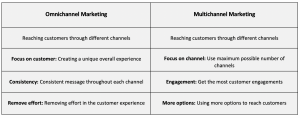

In the last few years many new technologies have evolved and it became normal for people to use many different devices throughout the day to get their work done or get entertained.
Google found that 90% of multiple device owners switch between an average of three devices per day to complete a task. This opens the possibility for businesses to close cross-channel sales if they’re using the right approach, a market that is worth $1.8 trillion in 2020.
These changes have also brought new terms with them, one of which is omnichannel marketing. Omnichannel marketing is one way for businesses to take advantage of this whole collection of devices and platforms that users are connecting with today.
Often, new terms like this one are dismissed as just “another buzzword”, in this blog article we’ll show you why omnichannel marketing is so much more than this.
What exactly is omnichannel marketing?
Omnichannel marketing uses the power of all the marketing channels that are available and used by a specific group of customers through different devices and platforms, and combines it into one complete experience. This approach can include online channels as well as offline channels.
The core of omnichannel marketing is that the customer always receives a message that fits his progress in the sales funnel and therefore provides the ultimate personalized customer experience.
It’s also important to know that the focus should always be on the customer and not on the brand so it’s a lot about understanding the customer. Your customers should see you everywhere they are. So different than in traditional marketing you don’t use different mediums to reach different customers, you now direct every channel or medium to a specific customer.
Ultimately omnichannel marketing turns the sales process from a one time experience into a complete journey that continues over days, different devices, locations and channels.
What is the difference between omnichannel marketing and multichannel marketing?
As both of the terms are new they often get confused by people. This is mostly due to the similarity that they have. If we take a closer look at them though, it gets clear that there is an important difference between these two marketing concepts which have to be taken into consideration when you plan your strategy.
The easiest way to see the difference between omnichannel marketing and multichannel marketing is by looking at three characteristics.

The most important one is the goal of the two approaches, while multichannel marketing mainly aims to get the word out via the maximum possible number of channels and therefore also engage as many customers as possible. Omnichannel marketing on the other hand combines every channel used to engage with customers as a whole, to provide them with a unique overall experience and build stronger relationships.
The second difference is directly related to the first one, building strong relationships like omnichannel marketing requires consistency. This means the experience and messaging has to be the same throughout each channel to ensure an intense sense of familiarity and relationship with the business.
Another difference is that while multichannel marketing has many channels available to contact a customer, omnichannel marketing works on finding out where the customer experience exists and how it can be improved.
How you get ready to use omnichannel marketing
There are a few things that you should take care of before starting your own omnichannel marketing campaign:
Know your customers
To be able to create customer profiles for your omnichannel strategy and offer them a bespoke experience, you first have to get to know your customers. Understand who they are, what they are struggling with and what they want to achieve. Also learn about their user behaviour, what kind of content they like, when they consume it and most importantly, what channels they are using to access your content.
Create new structures
One of the biggest problems faced with omnichannel marketing strategies is siloed structures in organisations.
If you want to create a remarkable omnichannel experience you should work with an inter-departmental, agile approach. Having an environment where teams can work together and have a way to communicate to each other enables the different departments to find and optimise their place in the customer experience.
Build your Marketing technology stack
You should also make sure to have the right tools before you start.
There are two tools that are indispensable if you want to develop your own omnichannel marketing strategy. One is a customer relationship management (CRM) tool which makes it possible to keep track of each customer’s journey and the other one is an analytics tool which will provide you the information needed to make decisions about your overall strategy.
These two tools are the foundation of your technology stack, you can then complement your stack with other tools that are relevant to your strategy.
How to set up an omnichannel marketing strategy that benefits your business
Implementing an omnichannel marketing strategy requires you to follow some important steps. In the next section we give an overview into what these steps are.
Create customer profiles
With the knowledge you gained about your customers in the first round, create new customer profiles. Try to define as many diverse customer profiles as possible.
Define different segments
Once you have defined the different customer profiles with their buyer characteristics, you can create segments to which you can assign them.
You can later use your CRM to automatically segment your customers based on the profiles that you created. This helps you to send personalised messages to each segment.
Create content for specific customer journeys
Create different customer journeys for different customers, every buyer profile should have its individual content and support that meets their behaviour and habits. Make it as easy as possible for each buyer to convert.
Choose your channels and devices
You should only use the channels that really matter for your customers. Focus on optimising the experience on the channels your customers prefer to use and don’t waste your time trying to use every channel you can think of.
Observe your customer’s behaviour across channels with tools like social monitoring to find out which channel will work best for you.
Measure and optimise
To be able to analyse and compare the data from all the different marketing channels, you need a proper measurement strategy that keeps track of all the important information around your customers.
You should get a clear and actable insight on your initiatives instead of being overwhelmed by cross-channel data.
Implement the insights from this data throughout your different channels to create a seamless user experience. This requires that you share this information with all the teams that are involved and make sure that customers get the same response where ever they interact with you.
For more information about omnichannel marketing and our growth hacking services in Zurich send an email to hello@what.digital.